Platy fish are a popular choice for both beginner and experienced fish keepers. These small and colorful fish are known for their peaceful nature and low maintenance care requirements. In this guide, we will cover everything you need to know about keeping platy fish happy and healthy in your aquarium.
Platy fish require a clean and spacious tank, proper water temperature and chemistry, and a varied diet with high-quality food. Avoid overfeeding and provide hiding places. Monitor for signs of illness such as lethargy or abnormal swimming behavior. Consult with a veterinarian or experienced aquarist for advice on proper care.
Whether you are new to fish keeping or looking to add some new fish to your collection, platy fish are a great option. They are easy to care for and come in a variety of colors and patterns.
I personally fell in love with platy fish when I first saw a group of them swimming around in a friend’s aquarium. Their bright colors and playful personalities immediately caught my attention.
In this article, we will cover the basics of platy fish care, including tank setup, water parameters, feeding, and breeding.
We will also discuss some common health issues that can affect platy fish and how to prevent and treat them. By the end of this guide, you will have all the knowledge you need to provide the best possible care for your platy fish.
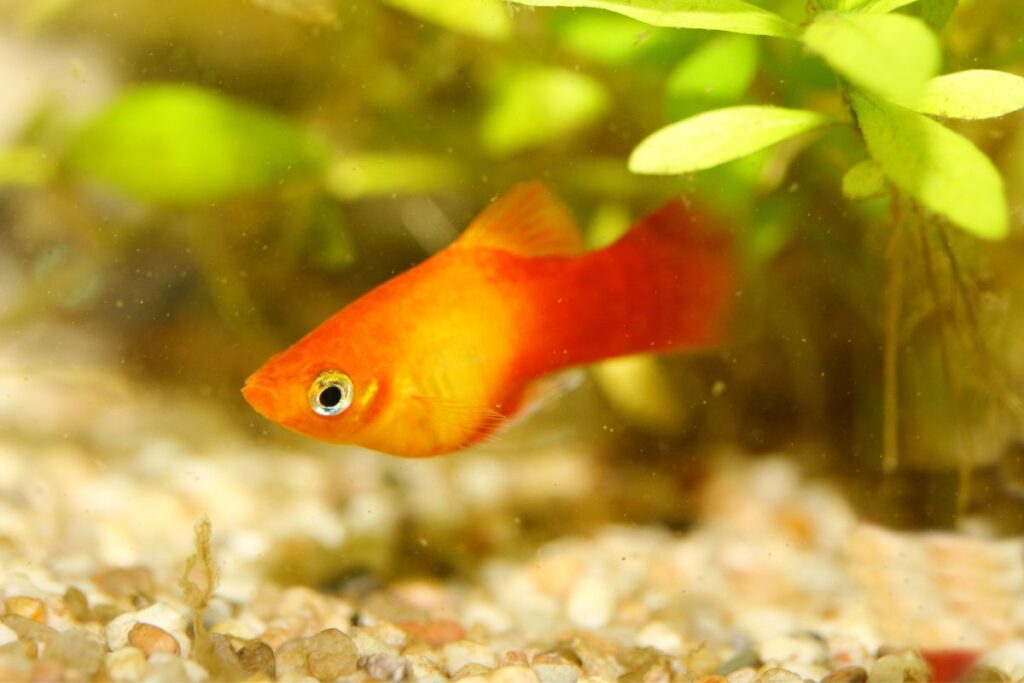
Table of Contents
Key Takeaways
- Platies are a popular and easy-to-care-for fish species that come in a variety of colors and patterns.
- To keep your platies healthy, it’s important to maintain suitable water parameters, including a temperature of 72°F to 78°F, a pH of 7.0 to 8.2, and a hardness of 10 to 20 dGH.
- Platies are omnivores and can be fed a variety of foods, including flakes, freeze-dried foods, and pellets.
- The minimum tank size for platies depends on the number of fish you have, with 10 gallons recommended for 1 to 2 platies, 20 gallons for 3 to 4 platies, and 30 gallons for 5 to 6 platies.
- To set up a suitable tank for platies, you’ll need equipment like an aquarium, a filter, a heater, lighting, substrate, and decorations.
- To maintain water quality, it’s important to perform regular water changes, with a frequency of weekly to monthly depending on the size of your tank and the number of fish you have.
- If you’re interested in breeding platies, there are several methods you can use, including livebearing, pairing, and group breeding. It’s also important to provide proper care for the fry once they’re born.
- Overall, platies are a great choice for beginner fishkeepers and can provide years of enjoyment with proper care and attention.
Species Summary
Origin
The Platy fish, also known as the Xiphophorus maculatus, is a freshwater fish species that is native to Central America, specifically Mexico, Guatemala, and Honduras.
They are commonly found in slow-moving streams, ponds, and other freshwater bodies.
Appearance
Platy fish are small, colorful, and easy to spot. They have a triangular body shape with a slightly rounded belly.
Their fins are fan-shaped, and their tails are slightly forked. They come in a variety of colors, including red, orange, yellow, blue, and green.
Lifespan
With proper care, Platies can live up to three years. However, their lifespan can be shortened if they are not well taken care of.
Size
Platy fish are relatively small and can grow up to 2.5 inches in length.
Growth Rate
Platy fish are fast growers, and they can reach their full size within six months to a year.
Behavior & Temperament
Platy fish are peaceful and social creatures that enjoy swimming and playing with other fish. They are active during the day and rest at night.
They are also known to be hardy and can adapt to different water conditions.
Personally, I have had Platies in my aquarium for several years, and I have found them to be enjoyable and easy to care for.
They are always active and playful, and their vibrant colors add a beautiful touch to my aquarium.
Types of Platy Fish
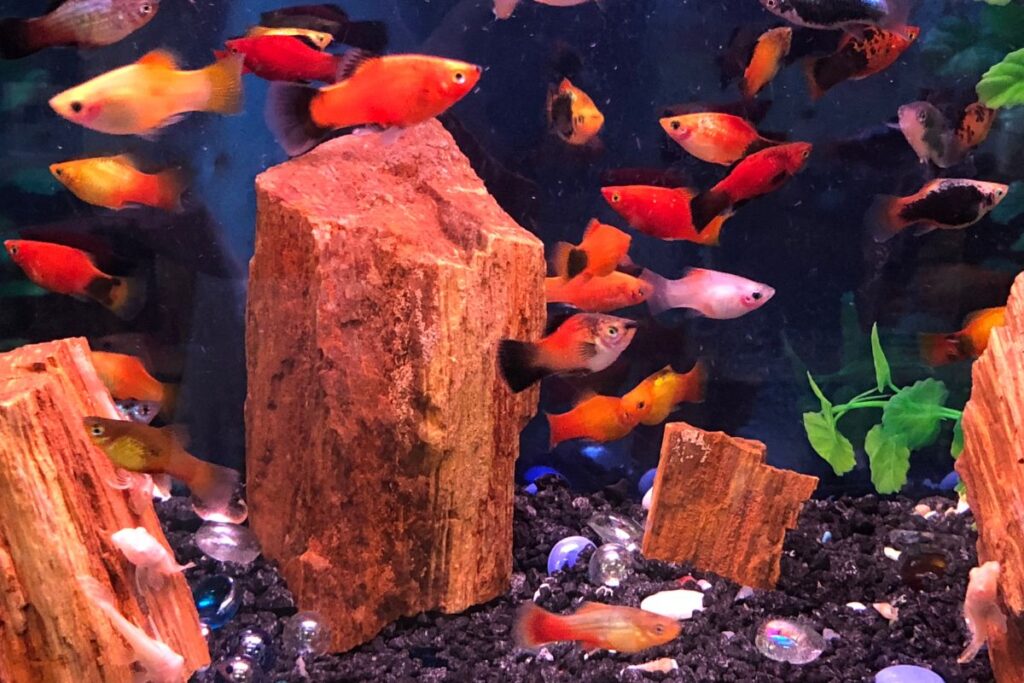
Platy fish come in several different varieties, each with their unique colors and patterns. Here are some of the most common types of platy fish:
- Red Wag Platy: This type of platy fish is known for its bright red coloration and black spots on its tail fin. I personally have a Red Wag Platy in my own aquarium, and it adds a beautiful pop of color to the tank.
- Mickey Mouse Platy: This variety of platy fish has a unique black spot on its body, resembling the iconic character’s ears. It also has a vibrant orange coloration.
- Tuxedo Platy: As the name suggests, this platy fish has a black tuxedo-like pattern on its body, with a contrasting yellow or orange coloration on the rest of its body.
- Moonfish Platy: This type of platy fish has a silver body with a crescent-shaped black mark on its tail fin, resembling a moon.
- Sunset Platy: With its bright orange and yellow coloration, this platy fish resembles a beautiful sunset.
When choosing which type of platy fish to add to your aquarium, it’s essential to consider their compatibility with other fish species and their specific care requirements.
Some platy fish may prefer a specific water temperature or pH level, so be sure to research each variety before making a purchase.
Choosing the Right Tank
Tank Size
When it comes to choosing the right tank for your Platy fish, size matters. The general rule of thumb is to have at least 2.5 gallons of water per fish. However, it’s always better to go bigger if you can.
A larger tank will provide more swimming space for your fish and help maintain a stable environment.
Personally, I made the mistake of starting with a small 5-gallon tank for my Platy fish. It wasn’t long before I realized that they needed more space to thrive.
I ended up upgrading to a 20-gallon tank, and my fish have been much happier and healthier ever since.
Shape of Tank
The shape of your tank is also important to consider. Platy fish are active swimmers and enjoy having room to move around.
A rectangular or square-shaped tank is the best option as it provides more swimming space compared to a round or bowl-shaped tank.
Another thing to keep in mind is the height of the tank. Platy fish are surface dwellers and don’t swim much in the lower parts of the tank.
A taller tank may look impressive, but it won’t provide your fish with the swimming space they need. A tank with a height of around 12-15 inches is ideal for Platy fish.
Overall, when choosing a tank for your Platy fish, consider the size and shape carefully.
A larger rectangular or square-shaped tank with a height of around 12-15 inches will provide your fish with plenty of space to swim and thrive.
Setting Up the Tank
| Equipment | Purpose |
|---|---|
| Aquarium | Provides a home for your platies |
| Filter | Helps to maintain water quality |
| Heater | Maintains a consistent water temperature |
| Lighting | Provides a day/night cycle for your fish |
| Substrate | Provides a natural environment for your fish |
| Decorations | Provides hiding places for your fish |
Setting up a tank for your Platy fish is an exciting process, but it requires careful planning and attention to detail.
Here are some important sub-sections to consider when setting up your Platy fish tank:
Lighting System
When it comes to lighting your Platy fish tank, it’s important to strike a balance between natural and artificial light.
I personally prefer using a combination of LED lights and natural sunlight to mimic the natural environment of my Platy fish. This helps to promote healthy plant growth and keeps my fish happy and active.
Filtration System
A good filtration system is essential for maintaining a healthy and clean environment for your Platy fish.
I recommend using a canister filter or hang-on-back filter, as they are both effective at removing waste and debris from the water. Be sure to choose a filter that is appropriate for the size of your tank.
Aeration
Proper aeration is important for maintaining oxygen levels in your Platy fish tank.
I use an air pump and air stone to create bubbles and increase water movement, which helps to oxygenate the water and keep my fish healthy.
Heating System
Platy fish thrive in water that is between 72 and 82 degrees Fahrenheit, so it’s important to invest in a good heating system.
I use a submersible heater that is easy to adjust and maintain, and I always keep an eye on the temperature to ensure that it stays within the recommended range.
Decoration
Decorating your Platy fish tank is a fun and creative process, but it’s important to choose decorations that are safe and appropriate for your fish.
I like to use natural materials like driftwood and rocks, as well as live plants, to create a natural and inviting environment for my fish.
Substrate
Choosing the right substrate for your Platy fish tank is important for maintaining water quality and promoting healthy plant growth.
I prefer using a fine gravel or sand substrate, as it is easy to clean and provides a good base for my plants to root in.
Plants
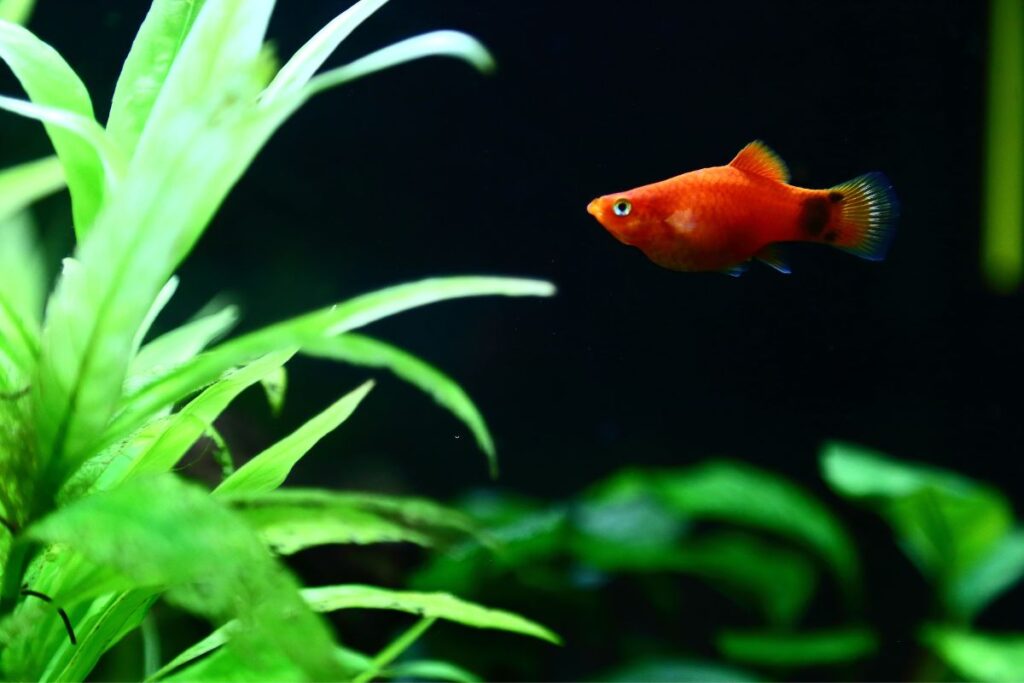
Live plants are a great addition to any Platy fish tank, as they provide natural filtration and help to oxygenate the water.
I like to use a variety of plants, including java fern, anubias, and hornwort, to create a lush and natural underwater environment for my fish.
Water Quality
| Water Parameter | Ideal Range |
|---|---|
| Temperature | 72°F to 78°F (22°C to 26°C) |
| pH | 7.0 to 8.2 |
| Hardness | 10 to 20 dGH |
As a responsible pet owner, it is important to maintain the water quality in your Platy fish tank to ensure the health and wellbeing of your fish.
In this section, we will discuss the different factors that contribute to water quality and how to maintain them.
Water Temperature
The ideal water temperature for Platy fish is between 72-82°F (22-28°C).
It is important to maintain a consistent temperature in the tank as sudden changes can stress the fish and make them more susceptible to diseases.
I have found that using a reliable heater and thermometer is crucial in maintaining the right temperature for my Platy fish.
Water pH
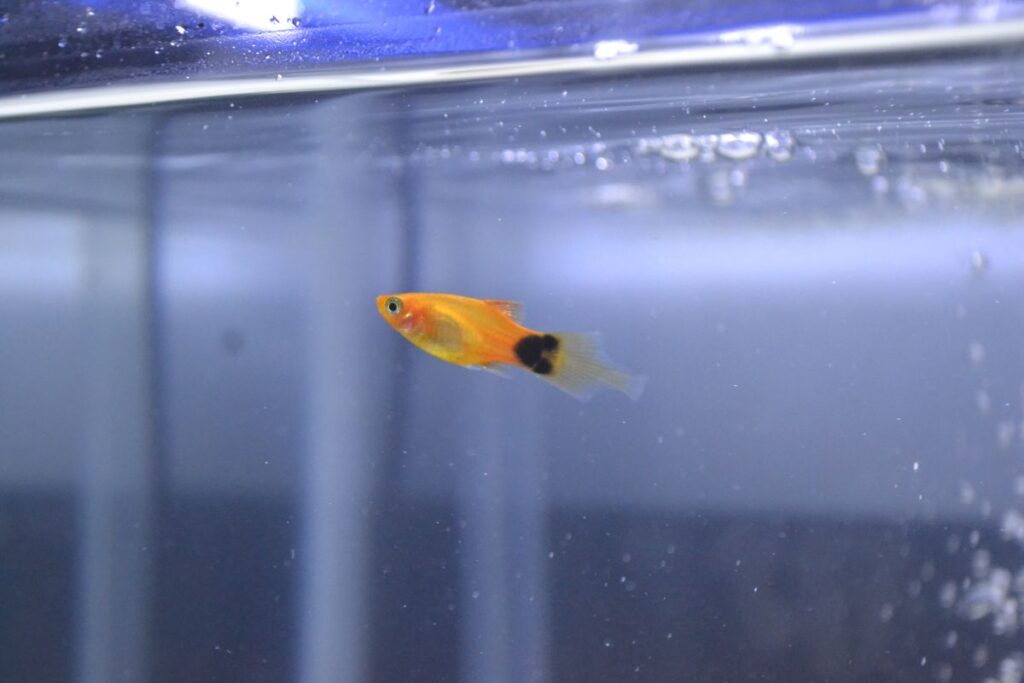
The optimal pH level for Platy fish is between 7.0-8.2. It is important to regularly test the pH level of the water and make adjustments as necessary.
I personally use a pH testing kit and adjust the pH level using aquarium-safe products. It is important to note that sudden changes in pH level can be harmful to the fish, so it is best to make gradual adjustments.
Water Hardness
Platy fish prefer slightly hard water with a range of 10-25 dGH. Hard water contains essential minerals that are beneficial to the fish.
I personally use a water hardness testing kit to ensure that the water in my Platy fish tank is within the optimal range. If the water is too soft or too hard, it can be adjusted using aquarium-safe products.
Overall, maintaining the water quality in your Platy fish tank is essential to their health and wellbeing.
By monitoring and adjusting the water temperature, pH level, and water hardness, you can ensure that your fish remain happy and healthy. With proper care, Platy fish can live up to 3-4 years and bring joy to your home.
How Often to Change Water in Platy Fish Tank
| Frequency | Amount |
|---|---|
| Weekly | 25% to 50% of the water volume |
| Bi-weekly | 50% of the water volume |
| Monthly | 75% to 100% of the water volume |
One of the most important aspects of keeping a healthy platy fish tank is maintaining clean water.
Water changes are necessary to remove excess waste, uneaten food, and other harmful chemicals that can build up over time. But how often should you change the water in your platy fish tank?
As a general rule of thumb, it is recommended to change 25-50% of the water in your platy fish tank every 1-2 weeks.
However, the frequency of water changes can vary depending on the size of your tank, the number of fish, and the filtration system you have in place.
Personally, I have a 20-gallon tank with 5 platy fish and I change 30% of the water every week. I find that this keeps my tank clean and my fish healthy.
However, if you have a larger tank or more fish, you may need to change the water more frequently.
It is important to note that when changing the water, you should only remove a portion of the water at a time.
Removing too much water at once can shock your fish and cause stress.
Additionally, you should always treat the new water with a water conditioner to remove any harmful chemicals before adding it to the tank.
Regular water changes not only keep your platy fish healthy but also promote a healthy and thriving ecosystem in your tank.
By removing excess waste and chemicals, you are creating a clean and balanced environment for your fish to thrive in.
Overall, the frequency of water changes in your platy fish tank will depend on a variety of factors.
It is important to monitor your tank and adjust the frequency of water changes as needed to ensure the health and well-being of your fish.
Tank Mates
When it comes to selecting tank mates for your Platy fish, there are several things you need to consider. One of the most important factors is compatibility.
Platy fish are generally peaceful and can coexist with a variety of other fish species, but there are some that should be avoided.
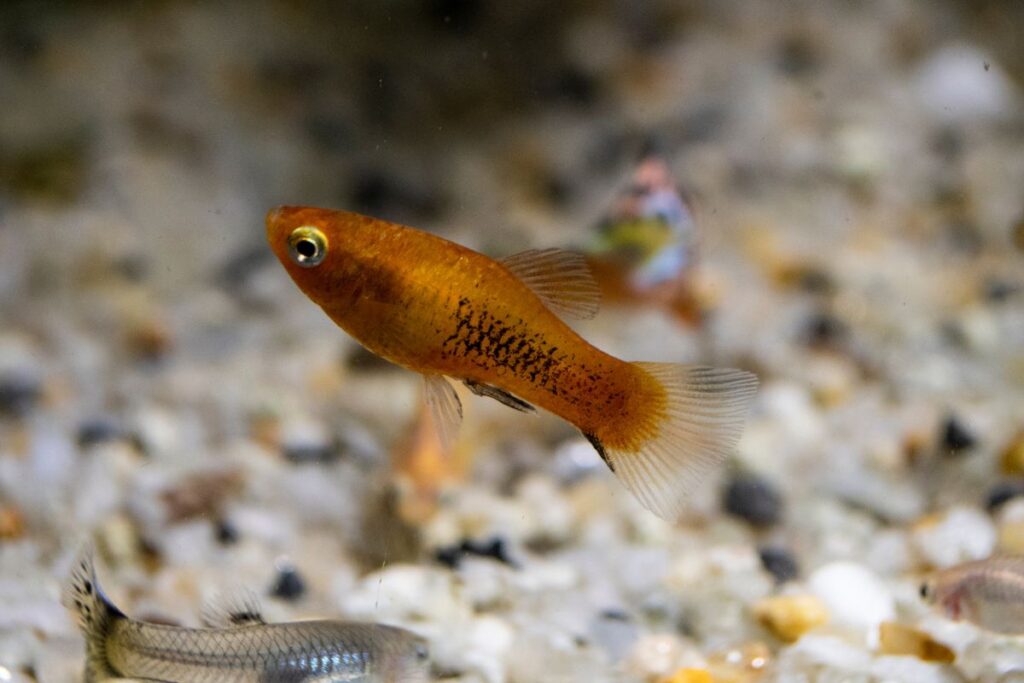
I have found that Platy fish get along well with other peaceful community fish. Some great options for tank mates include guppies, tetras, and corydoras catfish.
These fish are all peaceful and will not harm your Platy fish. In fact, they can help create a more lively and diverse aquarium environment.
However, it is important to avoid aggressive or territorial fish. Fish like cichlids, bettas, and angelfish can be aggressive and may harm your Platy fish.
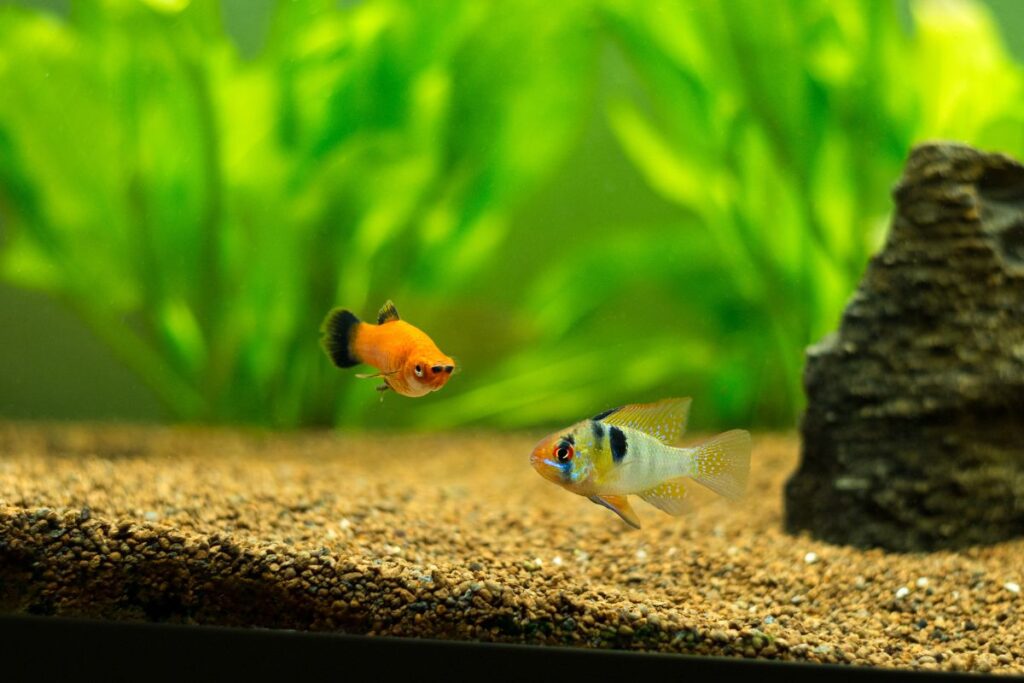
Additionally, some fish are known to nip at the fins of other fish, which can cause stress and injury. Avoid fish like barbs and some types of tetras that are known fin-nippers.
Another factor to consider when selecting tank mates is the size of your aquarium. Platy fish are small and do not require a lot of space, but some other fish species may need more room to swim.
Be sure to research the specific needs of any fish you are considering as tank mates to ensure they will be happy and healthy in your aquarium.
Overall, selecting the right tank mates for your Platy fish is important for creating a harmonious and thriving aquarium.
By choosing peaceful community fish and avoiding aggressive or fin-nipping species, you can create a beautiful and healthy environment for your fish to thrive in.
Personally, I have had great success with adding neon tetras as tank mates for my Platy fish.
They add a pop of color to the aquarium and are very peaceful. It’s always fun to watch them swim together and interact with each other.
Feeding and Nutrition
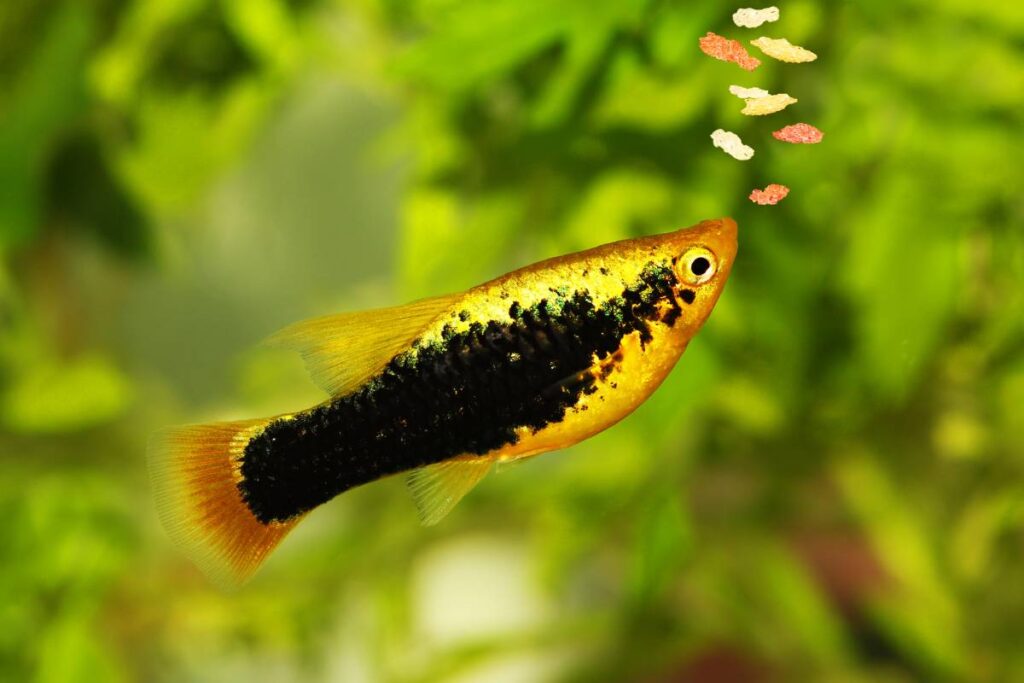
What to feed?
| Food Type | Examples |
|---|---|
| Flakes | TetraMin Tropical Flakes, Hikari Micro Pellets |
| Freeze-Dried | Bloodworms, daphnia, brine shrimp |
| Pellets | New Life Spectrum, Omega One |
Platy fish are omnivores, which means they can eat both plant-based and meat-based foods.
You can feed them a variety of foods, including flakes, pellets, frozen foods, and live foods. I personally prefer to feed my platy fish a mix of flakes and frozen brine shrimp.
It’s important to choose a high-quality fish food that contains all the necessary nutrients, vitamins, and minerals.
Look for fish foods that are specifically formulated for platy fish, as they will have the right balance of nutrients for your fish.
How often?
Platy fish should be fed once or twice a day, with only as much food as they can consume in a few minutes.
Overfeeding can lead to health problems such as obesity and poor water quality, so it’s important to be mindful of how much you’re feeding your fish.
When feeding your platy fish, it’s a good idea to turn off the filter for a few minutes to prevent the food from being sucked into the filter.
This will also give your fish a chance to eat in peace without the current pushing the food away.
In summary, feed your platy fish a variety of high-quality fish foods, and only as much as they can consume in a few minutes.
Remember to turn off the filter during feeding time to prevent the food from being sucked into the filter.
How Many Platy Fish Should Be Kept Together?
| Number of Platies | Minimum Tank Size |
|---|---|
| 1 to 2 | 10 gallons |
| 3 to 4 | 20 gallons |
| 5 to 6 | 30 gallons |
When it comes to keeping platy fish, it is important to consider the number of fish that should be kept together in a tank.
Platy fish are social creatures, and they thrive in groups. However, overcrowding can lead to stress, disease, and aggression. So, how many platy fish should be kept together?
As a general rule of thumb, you should keep at least three platy fish together. This will ensure that they have a social environment and can establish a hierarchy.
However, the size of your tank will also determine how many platy fish you can keep together.
A good rule of thumb is to have one gallon of water per inch of fish. So, if you have a 50-gallon tank, you can keep around 10-12 platy fish.
It is important to note that male platy fish can be aggressive towards each other. If you have male platy fish in your tank, it is best to have a ratio of one male to two or three females.
This will help to prevent aggression and ensure that your fish are happy and healthy.
Another factor to consider is the type of platy fish you have. There are several different varieties of platy fish, and some may require different care than others.
For example, some platy fish are larger than others, so you may need to adjust the number of fish you keep based on their size.
Personally, I have found that keeping a group of five platy fish in my 10-gallon tank works well. They are active and social, and I have not had any issues with aggression or disease.
However, it is important to monitor your fish and their behavior to ensure that they are happy and healthy.
In summary, when it comes to keeping platy fish, it is important to consider the number of fish that should be kept together.
A good rule of thumb is to keep at least three platy fish together, and to have one gallon of water per inch of fish. It is also important to consider the ratio of male to female fish, and the type of platy fish you have.
By following these guidelines, you can ensure that your platy fish are happy, healthy, and thriving in their environment.
Platy Fish Health
As a fish owner, it’s important to keep your platy fish healthy. Here are some common diseases, symptoms, and treatments to keep in mind.
Common Diseases
Platy fish are generally hardy and healthy, but they can still get sick. Some common diseases include:
- Ich: This is a parasitic disease that causes white spots on the fish.
- Fungus: This is a fungal infection that can cause white, cotton-like growths on the fish.
- Fin Rot: This is a bacterial infection that can cause the fins to deteriorate.
Symptoms
If your platy fish is sick, there are some common symptoms to look out for:
- Loss of appetite
- Lethargy
- Swimming upside down or sideways
- Erratic swimming
- Abnormal breathing
Treatment
If you notice any of these symptoms, it’s important to act quickly to treat your fish. Here are some treatments to consider:
- Medication: There are a variety of medications available to treat different fish diseases. Make sure to read the instructions carefully and follow them closely.
- Water changes: Keeping the water clean and well-maintained can help prevent and treat fish diseases.
- Isolation: If one fish is sick, it’s important to isolate it from the rest of the tank to prevent the spread of disease.
I personally had an experience with my platy fish getting fin rot. I noticed that his fins were deteriorating and he was swimming erratically.
I quickly researched the symptoms and treatments and decided to try a medication. Within a few days, his fins started to grow back and he was swimming normally again.
It’s important to monitor your fish’s health regularly and act quickly if you notice any signs of illness.
Signs Of A Healthy Platy Fish
Here are some signs of a healthy Platy fish:
- Active and alert behavior – A healthy Platy fish will be active and alert, swimming around the tank and interacting with other fish.
- Vibrant coloration – A healthy Platy fish will have vibrant and consistent coloration, without any fading or discoloration.
- Healthy fins and scales – A healthy Platy fish will have healthy and intact fins and scales, without any tears, fraying, or discoloration.
- Good appetite – A healthy Platy fish will have a good appetite and eagerly eat when food is offered.
- Clear breathing – A healthy Platy fish will breathe easily and smoothly, without any gasping or rapid breathing.
- No signs of disease – A healthy Platy fish will not show any signs of disease, such as lethargy, loss of appetite, or abnormal behavior.
- Active breeding behavior – If you have both male and female Platy fish in your tank, you may notice active breeding behavior, such as the male chasing the female and the female displaying a swollen belly.
It’s important to monitor your Platy fish regularly and look for any signs of illness or distress. If you notice any changes in behavior, appetite, or appearance, it’s important to take action quickly to prevent any further health issues.
Signs Of A Sick Platy Fish
Here are some signs of a sick Platy fish:
- Lethargy – A sick Platy fish may appear lethargic and inactive, spending most of its time at the bottom of the tank or hiding in plants.
- Loss of appetite – A sick Platy fish may lose its appetite and refuse to eat, even when offered its favorite foods.
- Rapid breathing – A sick Platy fish may breathe rapidly or gasp for air at the surface of the water.
- Faded coloration – A sick Platy fish may have faded or dull coloration, or patches of discoloration on its body.
- Abnormal swimming behavior – A sick Platy fish may swim erratically or have difficulty swimming, such as swimming upside down or on its side.
- Visible signs of disease – A sick Platy fish may have visible signs of disease, such as white spots (indicating ich), red streaks or sores (indicating bacterial infection), or fuzzy growths (indicating fungal infection).
- Swollen or bloated belly – A sick Platy fish may have a swollen or bloated belly, which can be a sign of internal disease or constipation.
If you notice any of these signs in your Platy fish, it’s important to take action quickly to prevent the spread of disease and improve the fish’s health.
You may need to isolate the sick fish in a separate tank and treat with medication or adjust the water parameters in the tank to improve water quality.
Breeding Platy Fish
| Livebearing | Platies give birth to live young |
| Pairing | One male and one female are paired together |
| Group Breeding | Multiple males and females are kept together |
| Breeding Tank | A separate tank is used for breeding |
| Fry Care | Fry are separated from adults and fed small amounts of food frequently |
Breeding platy fish is an exciting and rewarding experience. It’s relatively easy to breed platies, and they are prolific breeders. Here are a few tips to help you successfully breed platy fish.
Firstly, it’s important to have a breeding tank set up. A breeding tank should be at least 10 gallons in size and have a heater and a filter. The water temperature should be kept at around 75-80°F.
It’s also important to provide plenty of hiding places for the female platy fish, such as plants or decorations.
Once you have a breeding tank set up, you can introduce a male and female platy fish. It’s best to have a ratio of one male to two or three females.
This will help to reduce aggression and increase the chances of successful breeding. When the female platy fish are ready to breed, they will develop a gravid spot, which is a dark spot near their anal fin.
The male platy fish will begin to chase the female around the tank, and you may notice them performing a mating dance.

After mating, the female platy fish will give birth to live fry, which will be able to swim and feed on their own.
It’s important to remove the adult platy fish from the breeding tank once the fry are born, as they may eat their own young.
In my experience, breeding platy fish is a fun and rewarding hobby. Watching the fry grow and develop is a fascinating process, and it’s a great feeling to know that you have successfully bred your own fish.
Just remember to provide a suitable breeding tank and to keep an eye on the water parameters to ensure the health and wellbeing of your platy fish.
Recommended Amazon Products:
- Aqueon Aquarium Fish Tank Starter Kit – This kit includes a 20-gallon tank, LED lighting, a power filter, and a heater, making it a great option for those starting out with a Platy fish tank.
- Tetra Whisper Power Filter – This filter is effective at removing waste and debris from the water and is available in different sizes to fit different tank sizes.
- Tetra EasyStrips 6-in-1 Aquarium Test Strips – These test strips are easy to use and can quickly test the water temperature, pH level, and water hardness in your Platy fish tank.
- Marina Air Pump – This air pump is quiet and efficient, making it a great option for adding oxygen to your Platy fish tank.
- Seachem Flourish Tabs – These plant fertilizer tabs are easy to use and can help promote healthy plant growth in your Platy fish tank.
- API Aquarium Salt – Adding a small amount of aquarium salt to your Platy fish tank can help promote healthy gill function and reduce stress in your fish.
- Fluval Plant and Shrimp Stratum – This substrate is specifically designed for planted aquariums and can help promote healthy plant growth in your Platy fish tank.
- Marina Floating Thermometer – This thermometer is easy to read and can help you monitor the water temperature in your Platy fish tank to ensure that it stays within the optimal range.
- Seachem Prime – This water conditioner is effective at removing chlorine, chloramine, and ammonia from tap water, making it safe for your Platy fish. It also detoxifies nitrite and nitrate, which can be harmful to your fish if they accumulate in the water.
Conclusion
Overall, caring for Platy fish can be a rewarding and enjoyable experience for fish enthusiasts of all levels.
As I have learned through my own experience, providing a well-maintained tank with proper water conditions, a balanced diet, and a peaceful environment is key to keeping these fish healthy and happy.
Remember to regularly test the water quality and perform routine maintenance, such as water changes and filter cleanings, to ensure a clean and stable environment for your fish.
Additionally, be mindful of their social behaviors and provide plenty of hiding spots and plants for them to feel secure.
When choosing tank mates, it is important to research and select compatible species to prevent any aggression or stress. And always remember to introduce new fish slowly and monitor their behavior closely.
Lastly, don’t forget to enjoy the beauty and personality of your Platy fish. Watching them swim and interact with each other can be a calming and peaceful experience, and a wonderful addition to any home aquarium.
As I reflect on my time caring for Platy fish, I can say with confidence that it has been a truly rewarding experience.
From watching them grow and thrive to learning about their unique behaviors and personalities, these fish have brought me joy and relaxation in ways I never expected.
I hope that this guide has provided helpful information and insights for anyone interested in adding these colorful and fascinating fish to their own aquarium.
FAQs
Here are some frequently asked questions about Platy fish care:
Q: How often should I feed my Platy fish?
A: Platy fish should be fed twice a day with small amounts of food. Overfeeding can cause health problems and pollute the tank.
Q: Can Platy fish live with other fish?
A: Yes, Platy fish are social and can live with other peaceful fish such as tetras, guppies, and swordtails. However, avoid keeping them with aggressive fish as they may get stressed and become ill.
Q: Do Platy fish need a filter?
A: Yes, Platy fish need a filter to keep the water clean and healthy. A filter helps to remove waste, excess food, and harmful chemicals from the water.
Q: How often should I clean the tank?
A: It is recommended to clean the tank once a week. This includes changing 20-30% of the water, cleaning the filter, and removing any debris from the tank.
Q: Can Platy fish live in a bowl?
A: No, Platy fish cannot live in a bowl as it does not provide enough space and oxygen for them to thrive. They need a minimum of 10 gallons of water per fish and a proper filtration system.
Personally, I had a Platy fish that lived for over 3 years with proper care and attention. It was a joy to watch it swim around and interact with the other fish in the tank. With a little effort and knowledge, anyone can provide a happy and healthy life for their Platy fish.
Reference: Wikipedia.
